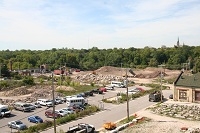The Milwaukee Rotary Centennial Arboretum will open on September 28th, 2013. Each month, Aaron Zeleske, Arboretum Project Coordinator, provides an update to tell a piece of the Arboretum story. These updates can also be found on the Rotary Club of Milwaukee website.
First, we must deal with environmental contamination present in the soil, the residue of the historical industrial uses of this land.
As part of the due diligence process, we hired environmental engineers (Sigma) to conduct a Phase I Environmental Site Assessment, which investigates the historical uses of a property to discern whether any contamination is likely. The engineers verified that the land had been occupied by a manufacturing facility of the National Brake and Electric Co. and a warehouse used by various entities. This property was also used by the North Western Wrecking Co. as an alleged construction-related landfill.
Because past uses of a property are associated with possible environmental contamination, a Phase II Environmental Site Assessment was done, which includes testing of soil and groundwater at a number of locations and depths throughout a property to identify any hazardous substances that may be present. The Phase II assessment found high levels of lead and arsenic, in addition to several other potentially hazardous compounds. While these materials do pose a danger, they do not contaminate the ground water on site and are only dangerous if ingested.
Working with the Wisconsin Department of Natural Resources, the environmental engineers formulated a Remediation Action Plan calling for a cap of 24 inches of clean material over the contaminated soil. The contractor we have hired to do the earthwork is importing the clean material from off site. In addition, a warning barrier will be placed between the contaminated and clean material. This barrier serves as a notification if the cap is punctured.
These measures will ensure that the community is insulated from the hazardous materials on site, as well as providing fertile soil necessary for the Arboretum’s plants to thrive for decades to come. This transformation of polluted post-industrial land into vibrant habitat is what makes the Milwaukee Rotary Centennial Arboretum such a compelling vision.





